SPACESHIPS
List of spaceshipsEagle Transporter
By Scott Iles
The Eagle Transporter is a size class two system ship.
It has rudimentary astrogation equipment and basic
flight controls. Its unique feature is the detachable
payload module, which can be swapped out quickly to
convert the ship for various missions. Three of the
most common modules are detailed below.The Eagle is not equipped to enter the dense
atmosphere of a Class-M planet, or to land on anything
with more than a .1g gravitational field. It is used to
transfer personnel and material between stations and
trips between nearby planets.
1. COCKPIT MODULE - This is the control center of the
ship. There are seats and consoles for the pilot, co-pilot
and communications/navigator. Note that the center
position (Comm./Nav.) does not have a forward
viewport.
2. ACCESSWAY - This access passage connects the
cockpit with the module in the center. The main life
support systems can be accessed in this area. There
are pressure doors at either in in the event of
atmosphere loss.
3. ENGINEERING - The monitoring equipment for the
chemical drives is in this small area. Only two humansized
beings (or 1 Vrusk) can fit in this compartment.
PASSENGER MODULE
4. PASSENGER COMPARTMENT - Forty-six comfortable
seats allow the passengers to relax as much as possible
on flights between bases. Video panels on the forward
bulkhead display entertainment and flight status
information.
5. AIRLOCK - Most modules have two airlocks, one on
either side. Storage lockers in each airlock have four
standard spacesuits. It takes one minute for the airlock
to cycle either way (pressurized to vacuum, or vacuum
to pressurized).
6. GALLEY - This small compartment contains
foodstuffs and prep equipment. Normally, only the food
for the next meal is stored here, with the rest of the
supplies kept in underdeck storage compartments.
7. HEAD - These are small, but fully equipped
refreshment stations. A retractable curtain converts the
outboard half of the space into a zero-g shower.
MEDICAL SUPPORT MODULE
9. PATIENT WARD - Eight double bunks provide bedspace
for up to sixteen patients. This module is used
for responding to disasters and transporting patients to
more advanced care facilities.
10. LOUNGE - This is similar to the lounge in the
passenger module, but replaces one of the tables with
two double bunks for the medical staff to use or
additional patient space.
CARGO TRANSPORT MODULE
8. LOUNGE -This area allows the passengers and crew
to get up and move around during flights.
Entertainment displays and tables allow for
socialization and recreation.
11. CARGO BAY - This module opens up as much space
as possible for the transport of cargo. Note that this
module only has one airlock, on the starboard side. The
hatch on the port side is used for loading in a
pressurized environment.
12. CREW LOUNGE - This small area allows the crew to
rest during long flights. An Eagle with this module
normally operates with only two crewmen.
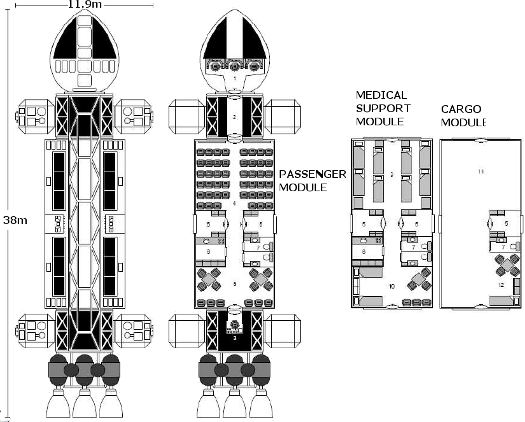
| Hull Size: | 2 |
| Engines: | 1 Chemical (four thruster nozzles) |
Life Support Capacity: | 6 (Cockpit Pod), Module capacity varies |
| Computer: | Level 2 (17 function points) |
| Programs: | Drive 1; Alarm 1; Damage Control 1; Astrogation 2; Information Storage 2 |
| Equipment: | Videocom Radio, Radar |
51
Explorer-Class Heavy Scout Craft
By Bill Logan

The civilian sect is ripe with explorers looking to make a name for themselves. Scientists from all walks look for an opportunity to find a new discovery and claim it as their own. Over time, they’ve relied on paying the high costs for modified military vessels dumped by the UPF or cycled out of production by corporate executive orders. The civilian scientific community, tired of getting hand-me-downs not actually created for exploration, are happy to hear the news of the release of the Explorer-Class Heavy Scout.
Design Goals
Designed specifically for private UPF-contracted exploration teams, the Explorer-Class Heavy Scout is
an interstellar-capable starship capable of performing most localized experiments and procedures when
surveying foreign soil, be it asteroid, rogue planet, comet, sun, or world. The ship is basically a hull size 5 long cylinder, roughly 100 meters from bow to stern. It’s twice the size and displacement as the ever-popular Assault Scout, but is nearly as quick and maneuverable thanks to its twin type B Atomic engines (unusual for a civilian craft because of the affordability factor).
Being able to land on a planet is normally a high priority for an exploration vessel. However, being able
to sustain faster-than-light speeds normally requires a vessel too large to enter an atmosphere. This ship is no exception.
However, to allow explorers and scientists to land and carry out their missions, a smaller lander module, nicknamed the Expedition mounts to the top of the ship, mating with it. A valid hull-size 1 ship in its own right, the Expedition serves a multi-faceted role as escape launch, planetary lander, cargo and personnel ferry.
Finally, the ship was designed with exploration missions in mind. Its ten decks include the normal
array of crew accommodations and control decks, but a surprising amount of laboratory space. The outside of the ship includes a decent amount of instrumentationclusters as well. It is a ship designed to seek the unknown and put a name to it.
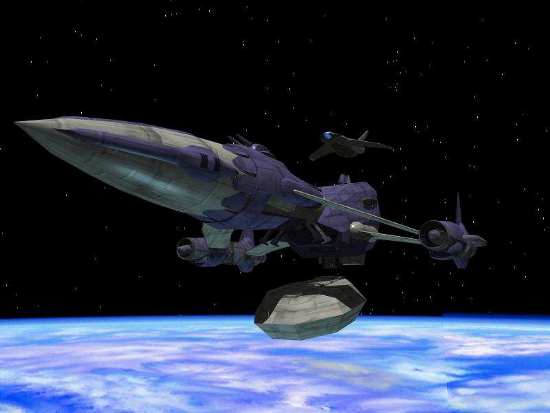

Since so much of the internal space is taken up with scientific and technological equipment, the cargo hold is located externally in a detachable bin, that can be jettisoned into open space so that the Expedition can detach from the starship and mount to the cargo bin and ferry it to wherever it is needed (between vessels, to dock at a planet’s surface, etc.).
The diagram shown at right highlights the detachable Expedition and Cargo module locations, and the images at show the detachment and cargo carrying features via photographs taken live during maneuvers.
Incentives to Private Groups
The United Planetary Federation wants to encourage private groups to undergo peace-time exploration.
Additionally, corporations like Pan-Galactic Corporation, Streel, and others are similarly interested in neutral third-parties offering up their exploration skills for hire.
Because of this, the Explorer Class Heavy Scout starship is the first of its kind to have its sale subsidized by the UPF and seven mega-corporations, reducing the cost to the consumer. This basically cuts the price to half normal.
Getting Around on Deck
The starship is designed using the standard Knight Hawks perpendicular concept, with the “bottom” deck being at the tail of the craft. The top-most deck (Deck 1) is the smallest, and is located at the nose of the craft. Access to the Expedition is via a hatch on Deck 10, while access to the detachable Cargo Module is on Deck 7.
Hatches have standard airlocks. Internal doors slide into the walls at the push of a button on the door itself. Doors can be locked by typing a code on a key panel on the door, though a master key number is known to the ship’s owner (and can be changed only by him or at a repair center).
Doors marked with a yellow and black border (on the deck plan maps on the following page, they’re shown colored in yellow) are locked by default, and must be unlocked by someone trusted with the security key number.
The deck plans found on page 31 are typical, though individual designs may vary. Squares on the map are 2 meters across.
Elevator. A single elevator shaft runs through the entire length of the ship. It is relatively small in size. Eight human-sized occupants are possible, though this is less a weight limitation as it is a space limitation. The elevator can traverse one deck per 6-second turn. Since the ship has ten decks, the longest one would have to wait for a lift is one minute, assuming the elevator wasn’t being held open at a given floor. The ship’s owner is given a master override that allows him to take control of the elevator, locking out all others, if he needs to.
Crew Cabins. Deck 6 has crew accommodations. Each room varies in size and shape, but all share a few common features: a modest bed, a small personal desk with computer terminal, intercom, and small night stand. They lack portals of any sort, though the conference lounge on this same deck has a single portal to view the planet around which the ship is orbiting.
Deck 9 also has some accommodations, though these are not quite as stately as the crew’s own cabins. This open area lacks personal space, and is typically used to house scientists or technicians hired on (or who booked passage) for specific exploration missions.
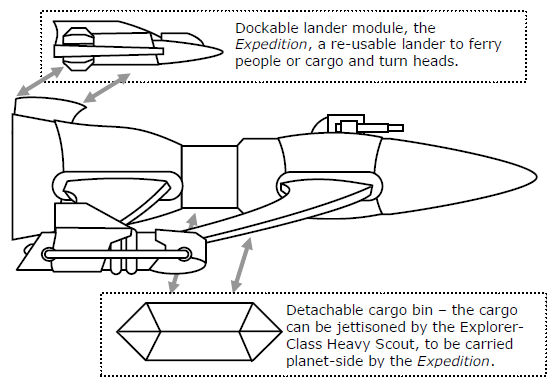
Defenses
The ship is not a military one. Its framework and superstructure lack the strength to take much damage, and the number and power of defenses are limited. However, even a civilian ship runs into trouble now and then, so the Explorer Class Heavy Scout vessel is equipped with only to defenses: a laser battery (controlled from Deck 1) and a Masking Screen dispenser (controlled from Deck 8). A Reflective Hull rounds out the defensive power of the craft.
Buy One Today!
Because of the subsidies paid by several megacorporations, the Explorer Class Heavy Scout ship is
quite affordable. With a basic set of science and technical labs, ion drives, and not much in the way of
luxury, the entire package will cost you less than a million Credits.
Contract
When you purchase an Expedition Class Heavy Scout, you can take the option of purchasing it
“under contract.”
Gambling on the intrepid success of private exploration teams, the special interests (private investors, mega-corps, etc.) worked together to set up this special economic aid package.
What’s in it for you
The core ship (not the Expedition) will cost the characters only sixty percent of the price the ship
would normally cost using the Knight Hawks rules.
What’s in it for them
But of course, this isn’t a grant, it’s a binding agreement; there’s something in it for them as well.
For ten years after purchase, forty percent of the value of all findings are given to the investors,
divided up among them according to the percentages they all contributed. The end result: more adventurous private explorers, less expense for the investors. Everyone wins. If the characters bound by the contract don’t make any discoveries or stake any claim over any resource before
the ten year period is over, they become responsible for paying back the forty percent that was paid, with one hundred percent interest.
Contract Buy-Out
Some characters may not like being bound like indentured servants to unknown parties. They might
not enjoy being the pawns of the kings of space. Heck – they may even find one or more of those
megacorporations clashing with them over some of their findings! After all, Streel would love to have 100% of the mining rights on that moon you just discovered! Therefore, there is an option to get out of your contract. All it takes is money… lots and lots of money.
But if you fear this, don’t enter such a contract. Space is a big place full of Credits – find a way to get some, and just buy this wonderful ship full-price!
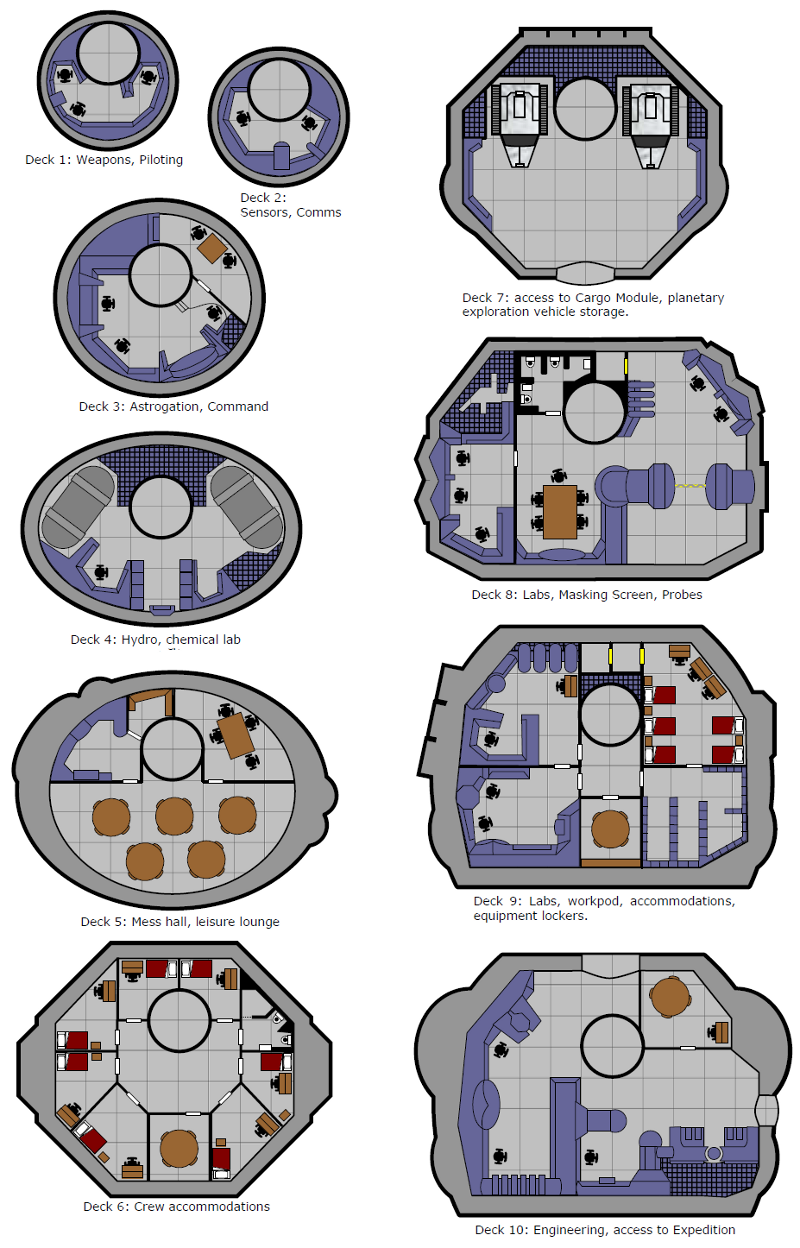
29-33
Personal Runabout
Download Issue #7
By Bill Logan
Author’s Note: I’ve used this in my games for a long time, and though it’s not strictly compatible with Knight Hawks, it serves an important but missing role in Alpha Dawn games. All of the math here is derived from the Alpha Dawn book. The only assumption made by me is the amount of energy required for 1LY of travel. Whether or not there is artificial gravity or food or whatnot is all abstracted, just like it was in Alpha Dawn.
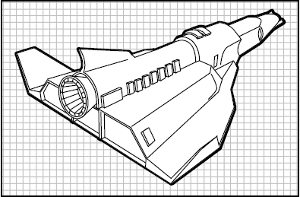
The Alpha Dawn Expanded game has rules for covering all
manner of ground and air vehicles. If your characters
need to get from star system to star system, there really
seems to be only two solutions: book passage on a
starliner, or buy Knight Hawks and build a ship.
The vehicle presented here is a missing-link alternative to
those two options. It’s a small shuttle capable of entering
orbit, flying around like an aircar, and short interstellar
trips. It’s a runabout – and it’s available to wealthy
travelers and adventurers who don’t like public
transportation or who need to live life off-the-grid.
Speed. Substantially less expensive than a starship, it
travels at a rate of 1 LY per two days (using the Alpha
Dawn methodology of star travel). Thus a trip from Araks
to Athor would take 16 days from port to port.
Range. The vessel is not capable of sustaining life support
or operating its engines past 20 days of continuous
operation. Therefore, it is not possible to take a voyage
beyond 10LY distance. For this reason, you will not find
Personal Runabouts in systems like Lynchpin whose
nearest neighbor is 14 Light Years away.
Power. The Personal Runabout uses a Type 2 Power
Generator. Operating and maintaining any type 2
generator requires a cost of 200Cr per day of use. The
generator creates 1,000 SEU (we’ll call that 1kSEU) per
hour (that’s 20kSEU per day). The Runabout consumes
40kSEU to travel 1 LY, which amounts to two days worth of constant generator output. Therefore, it costs 400Cr per LY traveled for generator fuel and maintenance consumables. The maximum cargo capacity for fuel and consumables is 400kSEU (10LY distance, a total cost of 4,000Cr to “fill ‘er up” from empty... 10Cr per 1kSEU). Additionally, the engine compartment has 2 type 4 parabatteries (a total capacity of 8kSEU). These allow for travel within an atmosphere, at a speed and range equal to that of an aircar. Because of the added mass, it uses these two parabatteries at the same rate an aircar would normally use its one. A runabout normally has a range of 1,000 km on its 8kSEU supply, meaning it drains 1kSEU from the parabatteries every 125km. The power generator can recharge the parabatteries in 8 hours but this drains 8kSEU from the remaining power.
Damage Capacity: If shot at, it uses the same rules as
would an aircar while in an atmosphere. If it is hit in
space, it will be destroyed with 1 hull point worth of
damage. Its small size allows it to dock on other ships (in
Knight Hawks rules, any ship of hull size 5 or greater) and
refuel there, or on space stations.
Crew & Cargo: In Alpha Dawn rules, the Personal
Runabout is treated like an aircar while in atmosphere,
and like a slow-speed starliner while in space. It has a
maximum crew capacity of 6 passengers, and enough
cargo space for 2,000kg (up to 4 cubic meters) of
additional equipment (not counting fuel and generator
consumables, detailed above).
Example: Gruno Trel has a price on his head, and
doesn’t trust anyone to supply him with an illegal ID.
He has the money and so purchases a Runabout for just
under half-a-million credits. It has room to bring along
up to five of his buddies, and carry around most of his
possessions in its cargo compartment.
He fuels up for a long voyage, filling up the Runabout’s
fuel compartment at a cost of 4,000Cr. This give him
400kSEU of power. He takes a trip from Prenglar to
Dixon’s Star (a 5 LY voyage). The trip takes 10 days
and drains (40x5=) 200kSEU from his supply. He has
200kSEU remaining.
He then has a long-range adventure on Laco (an
outpost planet in Dixon’s Star) where he travelled
300km in-atmosphere. This drains his parabatteries
around 3kSEU (1kSEU per 125km) leaving his
parabatteries at 5kSEU.
Gruno spends 3 hours recharging his parabatteries
while he sleeps, which drains his main generator’s
supply by 3kSEU. His main supply is now at 197kSEU.
He needs to refuel before his return trip to Prenglar.
Gruno refuels his generator supply for the return trip.
He goes to any shop that sells power generator supplies
and fuels. Since he wants to fill up his Runabout, he
notes that he is currently (400kSEU – 197kSEU =)
203kSEU short. This costs him 2,030Cr.
Fuelled and ready, Gruno takes off and heads back to
Prenglar to collect his payment for his mission on Laco.
He calculates his expenses and realizes he better ask
for more money from his employer... the trip cost him
4,030Cr in fuel and supplies, not to mention
ammunition and other costs.
Summary: A Personal Runabout costs 550,000Cr and
includes a type 2 generator and two type 4 parabatteries,
without fuel. In atmosphere, consider it just an oversized
aircar. In space, it travels 1LY per 2 days. Fuel for the
generator is 10Cr per 1kSEU. It requires 40kSEU to travel
1LY. Max capacity 400kSEU.
24